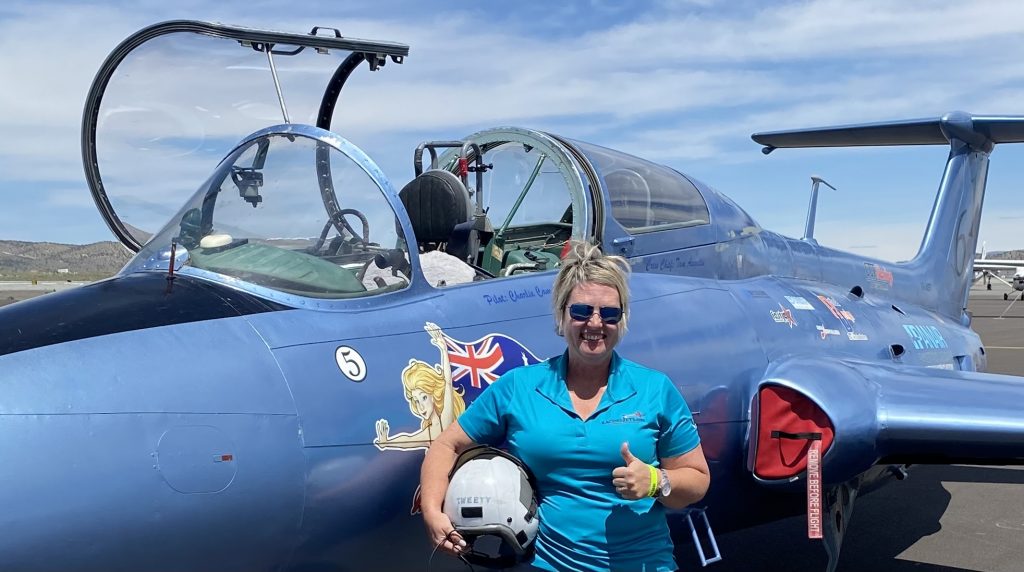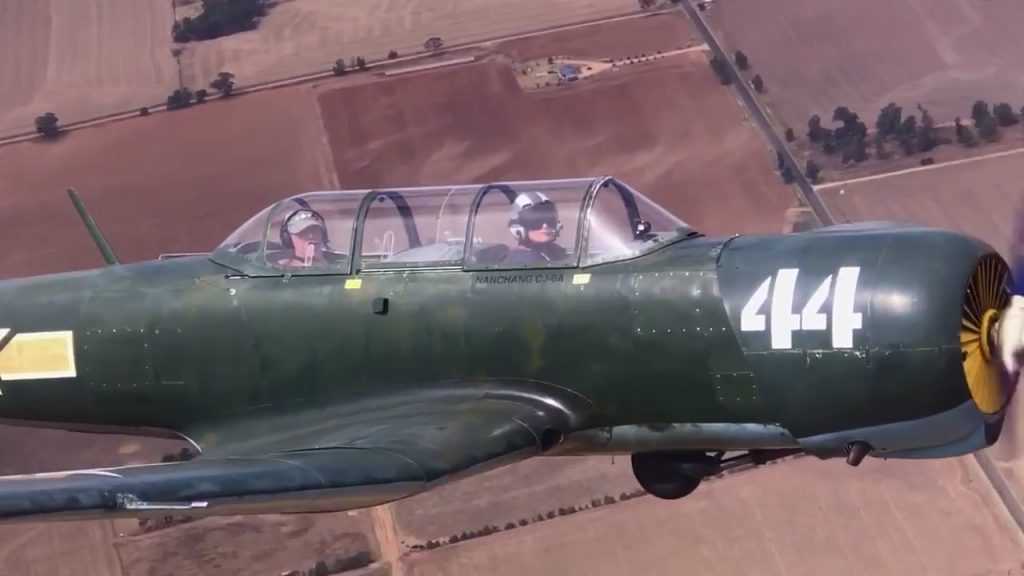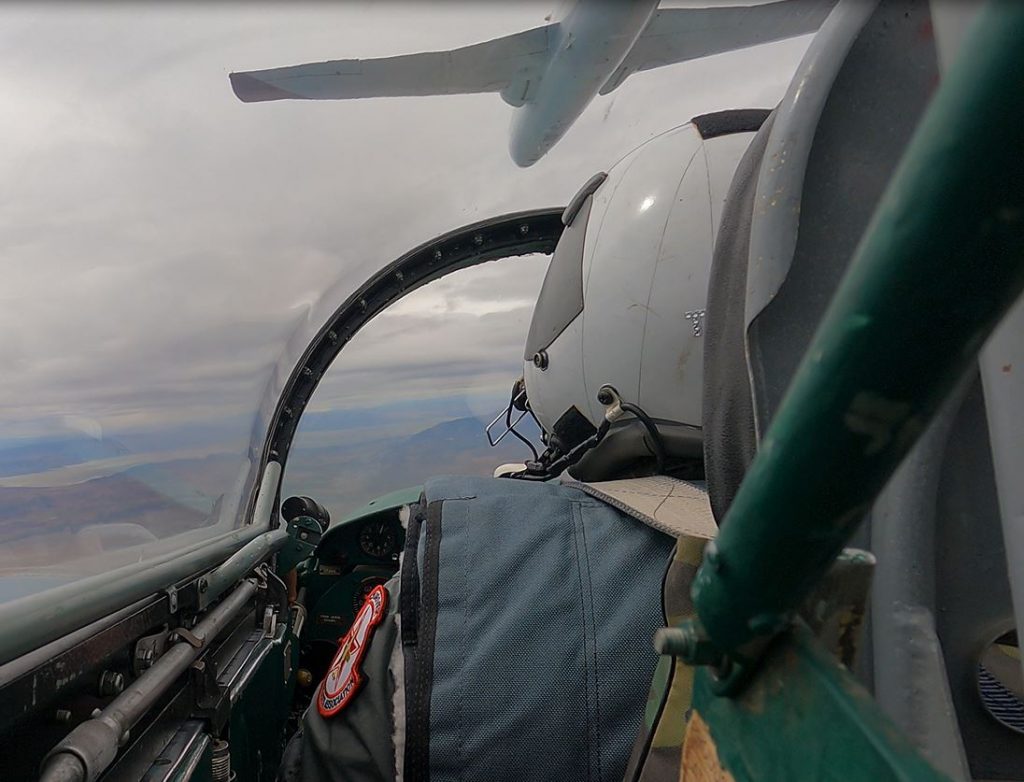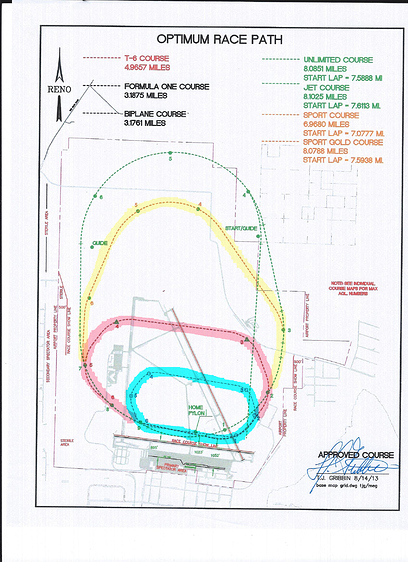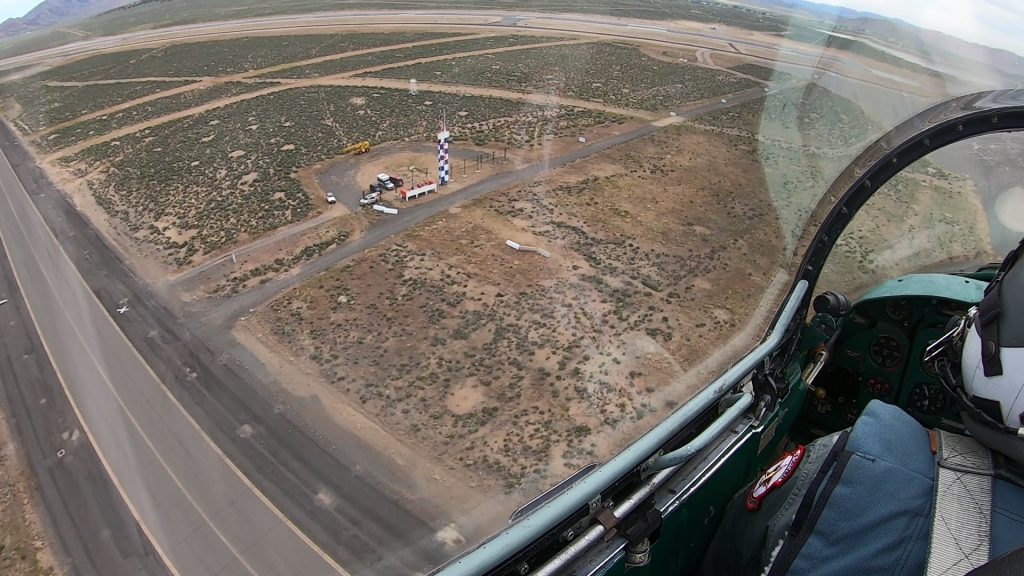In June 2013, I attended my very first Pylon Racing Seminar as an observer and ground crew for my husband Charlie, who was undertaking the PRS training as a ROOKIE Jet racer in our L29 Delphin Jet. What an eye-opening experience that was and an incredible opportunity to see behind the scenes and learn all about Reno Air racing. Each year after that I have attended both PRS and the races as crew for our jet race team and I have had the opportunity to see how it works, meet the people and gain an understanding of the intense skill set required to fly a jet aircraft in the race with our involvement with Racing Jets.
Now I need to be entirely honest with you here, when I first went to the racing all those years ago, I had no intention of wanting to undertake the training or to fly in the air races, and I was very happy to leave that to my husband, that was ‘His thing’….Oh How things have changed.
Over the last 9 years I have worked through my pilot training to add various ratings and endorsements to my licence. These have included command instrument ratings, multi engine flight instructor ratings, aerobatic and formation ratings and in 2015 a L39 Albatros Jet certification. At the time I found the L39 training was very intense and included 15 hours of flight training, 35 hours of ground school, upset recovery, my gas turbine endorsement and L39 Class type training with Australia’s most qualified L39 instructors Jay & Raeha Ekinci. To my surprise, after obtaining the qualification, I became first female to hold the rating in Australia on the L39 Aircraft.
Now I was feeling confident with my flying skills at this point, I probably had the basics sorted and I did meet the hour and legal requirements for PRS, so maybe I should have a go.
We sold our L39 in the US in late 2021, so that meant that if I really did want to try out for PRS, then I had to get trained up on our L29 Jet. The only challenge now, there was only one instructor in the whole country who could certify me which took some organizing. I set about studying flight manuals and training programs and in early May of 2022 I managed to complete my L29 Jet Training certification over an intense week. Again, earning the honour of being the first Australian female to hold the rating.
The training included a comprehensive ground theory component, upset recovery, aircraft handling and emergency procedures and a class rating flight review. This was only a few weeks before the JUNE PRS dates, which I felt was a good thing as I was very current on the airplane and felt comfortable in it.
2022 June – Formation Clinic – Reno NV
Prior to the PRS training, I had the opportunity to undertake 3 days of formation training in the L29 jet, flying with former US military pilots – some the best in the world, to standardize my formation skills to meet the initial entry requirements to participate in PRS.
I found this part of the training particularly challenging, as I had never flown formation in a jet aircraft and I felt extremely intimidated by the company of those I was lucky enough to be flying with, these guys and girls are the best of the best and here is little old me, never flown formation in a jet before. But I was intent on doing the best that I could do and if I didn’t get through this, I was already prepared that I would not be put forward to participate in PRS.
I had not just turned up unprepared, for those that know me well, know I am over the top in preparation. Leading up to the trip to the US, I had been working hard flying the L29, trying to familiarize myself with the jet, unfortunately I did not get any formation training in the jet prior to leaving Australia but I had been reviewing all my past formation training notes, watching videos and tutorials, and trying to get my brain around what I was about to undertake. It still did not fully prepare me for the difference in power/throttle control.
When I first did my formation endorsement in early 2021 in the CJ6 Nanchang, flying formation in a piston aircraft seemed almost natural for me, push the throttle forward or pull throttle back to change power settings and have an instant outcome, but in the jet it is nothing like a piston aircraft it is far more challenging.
The L29 Delphin, just like the L39 Albatros, has a good 12 second spool up and spool down time, so when you put the power on, it takes some time for it to result in a change of forward movement, this is the same when you take power off, nothing happens for a while, so the anticipation of what power inputs are required is critical to identify and react early otherwise you find yourself shooting forward or lagging behind the formation, this is not a good look and makes it very difficult for other pilots who are trying to hold the formation by flying off your wing. Additionally, we are travelling a lot faster through the air, the momentum and inertia are considerably different, and the closing rate is quiet a bit faster. Situational awareness is key.
Every flight I undertook, I had a qualified instructor in the back seat with me, and I can honestly say, these instructors are some of the best I have ever had the opportunity to fly with. The fact that they were some of the world’s best pilots was not lost on me and I certainly benefited from their instructional techniques and many years of experience They were not there to fly the aeroplane, that was my job, but they were there to help me fly solid, safe, predictable formation in the jet.
It took me the full 3 days to feel confident and gain the muscle memory skills needed to control the anticipation of spool up and spool down time of the jet. Every day commenced with a mass brief and then a pre-flight brief and at the end of the flight a de-brief on how the flight was carried out, how pilots performed, any call outs and any safety concerns.
Each day I came away with a new skill and always something I had to improve on. Usually after the debrief I already had identified what I needed to change and how to change it, but each night I would still go back to the hotel and review the training session in my head, go through the flight and analyze what I needed to do differently the next day and visualize myself making those changes. The next flight would always be an improvement and I could see the positive changes in my flying and my formation skills. Armchair flying for me, is a great way to visualize a change of mindset or technique.
I find that self-analyses is the best way for me to make positive changes in my flying, so long as I understand why I am making those changes. If I do not understand why I am changing something, I need to make sure I clarify it, otherwise the change I am making will not be a proactive one on my part, I will just be doing it because someone told me I should.
The final day of the formation clinic was fantastic, and I enjoyed it immensely. I felt that I had learnt so much in such a short time. I was under absolutely no illusion at this point of the clinic, it was completely in the hands of the senior instructors to approve if I was able to move forward to participate in the PRS clinic. If I didn’t get through, well I was more than happy to come back to Australia and do more formation training to work on my skills and try again next year, and if I did get through to the PRS clinic, it was another fantastic training opportunity for me to continue improving my flying skills.
I did get through, and the general comments from my instructors was that I had showed remarkable improvement each day and they wanted to see me progress through to the next round of training.
2022 June – NCAR PRS – Pylon Racing Seminar
Pylon Racing Seminar (PRS) – 4 days of intense training which commences with multiple ground briefings, race procedural training and then flying training. Pilots are required to undergo PRS to obtain their certification as a racer. PRS pilots are referred to as ‘Rookies’ throughout the week, we had 4 Jet class Rookies undergoing the training program.
There are different course layouts for the air racing which cover the requirements for the 6 different classes of aircraft: Jets, Unlimited, T-6, Biplane, Formula One, Sport Class. The Jet Class course is the same as the Unlimited course, 8.5miles in distance, 6 laps. Other classes have shorter course distances. This means there are lots of different Pylons on the course and you must be able to identify which course you are required to fly on or risk disqualification. The race has a speed limit of 525miles per hour, which some jets have the capability of reaching, our L29 would not reach that speed but has been timed at well over 400 miles per hour on the course in previous years.
Upset Recovery Training
The upset recovery training is designed to predict the pilot’s immediate reaction to being put into an unusual attitude so close to the ground (50 -250ft) flying at max speed of around 400 miles an hour. The training is done at altitude initially to prepare the pilot for the turbulence that can be experienced on the racetrack. This turbulence can be in the form of wingtip vortices, jet wash wake turbulence, low terrain, and wind. The aircraft is put into an inverted maneuver and the pilot must recover without loss of height. The most critical thing in this situation is that the pilot must not descend, obviously if you are only 50 feet off the ground that will end badly.
Maintaining situational awareness in an upset recovery situation is key, nose to horizon and recover. When you are on the track, there are many types of turbulence, and knowing where to fly your line behind another jet is vital so that you keep out of their jet wash. It can be a battle to keep the airplane flying where you want it to go so you do need to be firm and sometimes forceful. If you encounter severe turbulence sometimes the safest option is to get out of it completely, this requires the UP and IN procedure removing your self from the race entirely. Rather be safe than dead.
G-Force Training
During the race the pilots can experience intense G force. This can be from pulling tight in turns at high speeds, turbulence etc. Loss of consciousness during G force is referred to as G-LOC. During PRS pilots undergo G-LOC ground training, which is conducted by a medical practitioner, this training reviews the forces on the body and what pilots can do to prevent G-LOC from affecting them.
Racetrack Flying Training
This is designed to provide pilots with the required standards for flying race procedures and escape maneuvers for the racing. For the pilot, being predictable and solid in your flying is what they are looking for.
No low flying (below 50ft) no high Flying (Above 250ft) no show line or pylon cuts and correct use of escape maneuvers for safety. Flying a solid, smooth predictable line, 45 – 60-degree bank angle, with less G- Force loading will give a faster time than overloading the G force on the aircraft and slowing you down. Situational awareness of what is going on around you with other aircraft trying to overtake you is critical, use of radios and good airmanship when passing or being passed to allow for a safe race.
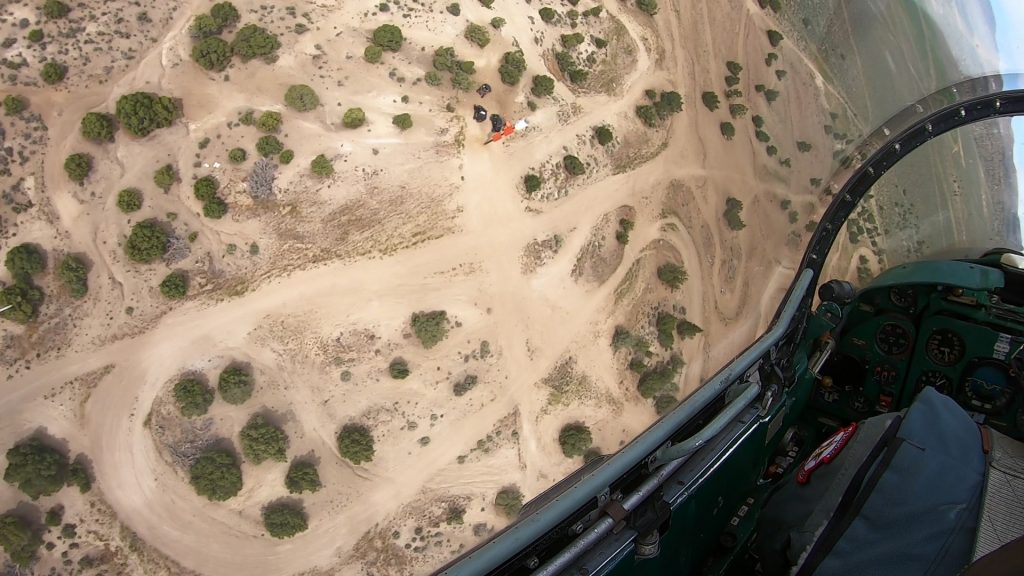
This type of training requires good verbalization from the instructor as the verbal delivery of information is a dominant source of information that influences underlying cognitive processes involved in learning motor skills associated with this type of flying, which is why this skill requires constant use to maintain and support such an erroneous skill.
For air race pilots the association of verbalizing and cognitive understanding what is required for this type of flying is critical when you are flying the course because your cognitive process is working overtime, critical thinking, motor skill and situational awareness all flying around the course, around 400 miles per hour, 50 feet above the ground. Therefore, having the ground briefings prior to the flight and a great instructor in the back of the aircraft is key to your success with this type of flying.
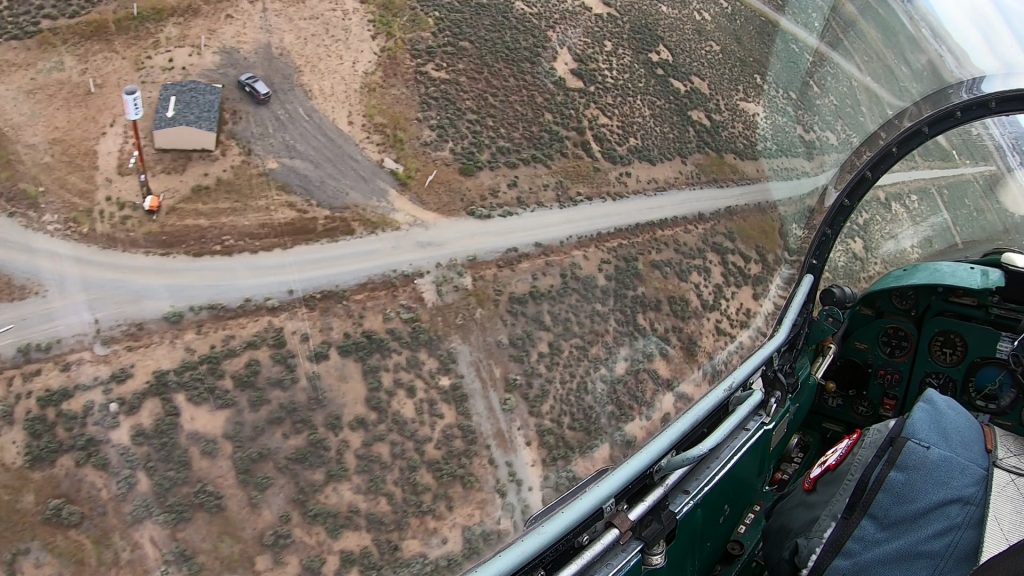
The training is conducted over 3 very intense days, with 2 flights per day. Mass briefings at 7am then class briefings prior to flights. The training flights are staged to be exactly like a real race, except during racing you are flying only 6 laps of the course, during PRS we would fly up to 16 laps. This allows for maximum time on the course for familiarization which is critical for being able to identify the pylons that you need to be flying around and not cutting. For me, each lap I learnt something, or saw something different, when you are flying so low and fast it is easy to miss a pylon or cut a show line. I also put a GOPRO camera in and at night I would go back to the hotel and watch it over and over, watch my line, when I should bank, when I should reduce bank, looking forward 2 pylons to see my line. Looking for shadows and approaching aircraft, watching my height.
Check Ride
The final day for me was so exciting, I had made it through so far, but I was under no illusion, this was it, everything I had been working towards was about to be assessed in one flight by multiple instructors. I had to perform to the highest standard and demonstrate that I deserved to be awarded this certification.
The flight was challenging, it was a full simulated Jet race with both Rookies and Certified Racers in the line-up. There were a few hiccups at the start with two other racers pulling up and out in the chute due to some congestion at the start, but I held my nerve, and I pushed that throttle full forward, flew my line for six laps and did the best that I possibly could do to fly the check flight to my highest ability.
After landing I was elated, what an incredible experience. I was very happy with my check flight, I had a couple of small errors, but nothing unsafe and I identified them to my instructor in the debrief and how I would change and improve going forward.
Don’t get me wrong, I was certainly under no assumption I had made it through, and the instructors were giving nothing away as they went off to debrief and decide my fate, but I was thrilled with how I had performed. This was one of the toughest training programs I had ever attempted, but it was one heck of a training platform, and I knew that I had grown as a pilot so much over that short period of time.
If I didn’t make it, of course I would be disappointed, but I really didn’t mind because I had learnt so much. Plenty of other pilots haven’t gotten through first go, it is not the end of the world, it just means you need more training to be safe.

It felt like hours before the instructors returned to deliver the outcomes on our check rides. But it was probably only 30 minutes. We were each individually briefed and advised if we would be progressing to the certified racer status.
When my instructor sat me down to debrief he told me that I was one of the 3 Rookies that had gotten through the training, I burst into tears (Not something I normally would do, and I was a bit embarrassed after!) The general comments from them all were great, they could not believe how I progressed, how I took every critique and every piece of feedback and came back the next day with any of the previous days issues fixed.
I was so extremely overwhelmed; I cannot explain truly how I was feeling at that time. To have that feedback from the people that I respected and looked up to was very grounding for me. My husband was bursting with pride and smiling so hard, I know without his support I would not have been there and I wanted to make him proud.
The sheer emotion of it all was so raw in that moment, the amount of time and energy I had dedicated, the sacrifices I had made, the financial costs and the physical and mental fatigue, the immense pressure I had put on myself had all come to huge pinnacle point of my flying career right there at that moment in time, it was surreal, this achievement was huge.
I have never been a person who is overconfident in my abilities, in fact I am the extreme opposite. My husband is always telling me to have more confidence in myself, that I am capable. But I have always struggled with self-confidence with anything I do, including flying. And no matter how hard I work, how intensely I train or study, I am continuously wondering why or how I managed to get through to where I am today. Do I really deserve to be here? Surely sometime soon, someone will work out that I am not really qualified to be here!
They call this “Imposter Syndrome” and in a nutshell that’s how I feel about myself all the time.
After my PRS training, I have made huge progress forward on my lack of confidence. I have learnt that no matter what barriers we place in front of ourselves, all we need to do is truly believe in ourselves, our dedication and our hard work will always prevail, and the ultimate outcome will be SUCESS! Even if we FAIL first time around, we will always succeed in the end.
I have realized that I do deserve to be here, I have worked extremely hard to be here and I should be here. I have as much dedication to this experience as the others in my PRS class, I do not need to be intimidated by other pilots’ qualifications and their success, I am not JUST a GA pilot…. I am a JET RACING PILOT and I am super excited to continue to build on my newest skill and inspire others to tackle their goals head on and achieve success in their lives.
My biggest learning outcome from this experience is don’t be afraid, just ‘do it afraid’, always face life’s challenges head on, be courageous, be bold, and in the midst of your fear you will build your own self-confidence, just believe that you are everything that you can be in this world and more.
